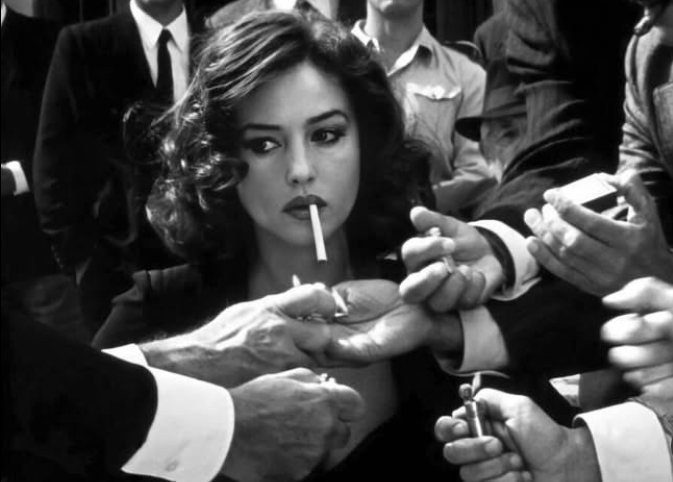Giuseppe Tornatore’s “Malèna,” released in 2000, is a film that intricately weaves the threads of nostalgia, beauty, and societal critique into a narrative set against the backdrop of World War II Italy. It serves as both a tribute to the golden era of Italian cinema and a reflection on the enduring complexities of Italian society. Through its rich storytelling and evocative imagery, “Malèna” captures the essence of a nation grappling with the remnants of its past while on the cusp of modernity.
Historical Context and Italian Neorealism
To fully appreciate “Malèna,” one must first understand the historical and cinematic context from which it draws inspiration. Italian neorealism emerged in the aftermath of World War II, a period marked by economic hardship and social upheaval. Filmmakers like Roberto Rossellini, Vittorio De Sica, and Luchino Visconti pioneered this movement, focusing on the lives of ordinary people and the stark realities they faced. Neorealism was characterized by its use of non-professional actors, on-location shooting, and narratives that highlighted themes of poverty, resilience, and human dignity.
“Malèna” pays homage to this era by setting its story in a small Sicilian town during the 1940s. The film’s aesthetic and narrative choices echo the neorealist tradition, capturing the struggles and aspirations of a community caught in the tug-of-war and its aftermath. Tornatore’s decision to frame the story through the eyes of a young boy, Renato, allows for a poignant exploration of innocence, desire, and the harsh realities of adulthood.
Plot Overview and Character Analysis
At the heart of “Malèna” is the story of Malèna Scordia, a beautiful and enigmatic woman whose presence becomes a catalyst for the town’s collective obsession. As the war progresses, Malèna’s life is scrutinized and judged by the townspeople, who project their fears, desires, and prejudices onto her. Her beauty, initially a source of admiration, becomes a burden as she navigates the societal expectations and moral judgments imposed upon her.
Renato, the film’s narrator and protagonist, becomes infatuated with Malèna, viewing her as both a muse and a symbol of unattainable beauty. Through his eyes, the audience witnesses the complexities of Malèna’s existence and the impression of societal norms on individual lives. Renato’s journey from boyhood to adolescence is marked by his evolving understanding of love, loyalty, and the harsh truths of the adult world.
Malèna’s character embodies the struggles faced by women in a patriarchal society, where their worth is often determined by appearance and reputation. Her resilience in the face of adversity highlights the broader themes of identity and transformation that permeate the film. Tornatore’s portrayal of Malèna is both a critique of societal hypocrisy and a celebration of feminine strength.
Cinematic Techniques and Aesthetic Choices
Tornatore’s directorial style in “Malèna” is a masterful blend of realism and romanticism, creating a visual and emotional tapestry that draws viewers into the world of 1940s Italy. The film’s cinematography, helmed by Lajos Koltai, captures the sun-drenched landscapes and cobblestone streets of Sicily with a painterly quality, evoking a sense of nostalgia and timelessness.
The use of color and light plays a significant role in conveying the film’s mood and themes. Warm, golden hues dominate the scenes featuring Malèna, symbolizing her allure and the idealized perception of her by the townspeople. In contrast, the darker, muted tones of the war-torn environment reflect the underlying tensions and struggles faced by the characters.
Ennio Morricone’s evocative score further enhances the film’s emotional depth, weaving a musical narrative that complements the visual storytelling. The music underscores key moments of tension, longing, and introspection, adding layers of meaning to the characters’ experiences.
Themes and Cultural Significance
“Malèna” explores a range of themes that resonate with both historical and contemporary audiences. At its core, the film examines the impact of societal norms on individual identity and the ways in which beauty and desire can both empower and entrap. Malèna’s journey is emblematic of the broader struggles faced by women in a patriarchal society, where their autonomy is often compromised by external judgments.
The film also delves into the concept of memory and nostalgia, reflecting on the ways in which the past shapes the present. Renato’s recollections of Malèna and the events of his youth serve as a lens through which the audience can explore the complexities of human experience and the passage of time.
Culturally, “Malèna” stands as a testament to the enduring legacy of Italian cinema, capturing the spirit of a nation in transition. Tornatore’s homage to the neorealist tradition is both a celebration of Italy’s rich cinematic heritage and a commentary on the timeless nature of its themes. The film invites viewers to reflect on the intersections of history, culture, and identity, offering a nuanced portrayal of Italian life during a pivotal historical moment.
Impression
Giuseppe Tornatore’s “Malèna” is a cinematic masterpiece that transcends its historical setting to explore universal themes of beauty, desire, and societal constraint. Through its compelling narrative, stunning visuals, and evocative score, the film captures the essence of post-war Italy while paying tribute to the golden era of Italian cinema. “Malèna” invites audiences to reflect on the complexities of human experience and the ways in which history continues to shape our understanding of identity and culture.
In celebrating the idiosyncrasies of Italian society, “Malèna” offers a timeless exploration of the human condition, making it a significant contribution to the world of cinema. As viewers journey through the sunlit streets of Sicily and the backgrounds of its past, they are reminded of the enduring power of film to illuminate the intricacies of life and the resilience of the human spirit.
No comments yet.







